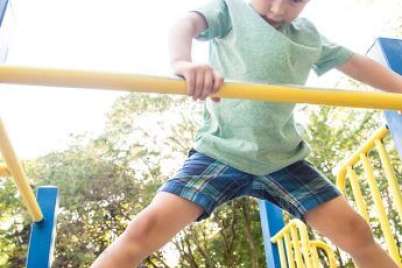
What to do when you and your partner disagree about risky play
Risky play is a hot topic at our house, and our arguments are always the same: I think my husband steps in too early. He thinks I step in too late. My husband thinks I let the kids bike too far ahead. I think he insists they stay too close.
As a former early childhood educator, I’m a huge advocate of risky play and my biggest fear is squelching our daughter’s innate bravery. I’m also a risk-taker myself. My husband, on the other hand, is far more risk-averse. We disagree on acceptable levels of risk and that’s not going to change.
Enter Dr. Mariana Brussoni’s lifeguard parenting approach. The lifeguard approach guides parents on how to step in when “actual danger” is present. For example, on the playground, “actual danger” could be a situation where the potential exists for a significant fall leading to a concussion. Instead of yelling, “Be careful!” when signs of danger arise, Brussoni identifies three stages of risky play, and appropriate, practical ways for parents to respond.
Here are three reasons why the lifeguard parenting approach helps reduce conflict when parents don’t see eye to eye on acceptable levels of risk:
1. It’s a neutral starting point
How much risk is too much? The answer is different for every person. Some people are risk-takers. Others are risk-averse. I have a rule at the playground: you can climb whatever you want at whatever height you want. The catch: you have to climb up and down on your own with no help from me. My husband disagrees. He worries that our kids will climb too high, lose their grip, and fall.
Brussoni’s approach takes the pressure off the risk-taking parent to push and the risk-averse parent to defend. Different parents step in at different times, but the message is no longer to avoid all danger. Instead, parents check in to make sure that their child is aware of the risks. That leaves children free to push their own limits, at their own pace—within safe limits. It helps that this guidance comes from an expert devoted to studying the positive effects of risky play, rather than the other spouse.
Related podcast: Dr. Mariana Brussoni on the value of risky play
2. It gets parents thinking about their own comfort level with risk
In her lifeguard approach, Brussoni stresses that parents should step in when there’s immediate danger. This advice is helpful because it encourages parents to step back and ask, “How do I view risk?” “What emotions does the word ‘risk’ trigger for me?” Asking these questions allows parents to evaluate whether their child is really at risk from a place of objectivity, rather than letting their fear of injury set the boundaries.
3. It focuses on the child
One of the keys to risky play is that it gets children taking risks that they themselves feel comfortable with. When kids are confident in their abilities, they begin to push their limits and develop confidence in their capabilities, ultimately increasing their self-esteem. Brussoni’s approach asks parents to take a step back in order for children to evaluate their own comfort level, rather than imposing limitations. Parents in conflict can use this approach as a tool to guide them in assessing risk, based on their child’s capabilities, rather than letting their fears guide them in a situation like whether it’s safe to climb a tree.
Parenting is tough, and when spouses don’t see eye to eye on topics like risky play, it can be stressful. Using the lifeguard parenting approach as a shared and neutral starting point helps parents observe their child’s capabilities and be aware and confident they will intervene when necessary, while continuing to build their child’s confidence through play.
Did we miss anything? How comfortable are you with risk? Are you and your spouse on the same page when it comes to acceptable risk? We’d love to hear your thoughts in the comments below.






I feel I could benefit from more examples and how to regarding this approach. On the surface it doesn’t seem to solve the dispute between the parents.
What I would do is let the husband take and exercise the kids one day and let the spouse exercise them the next day . . .It keeps harmony in the household and exposes children to different levels of risk and safety as well. . .
Regards,
John Garot